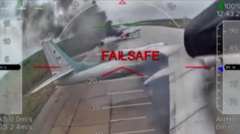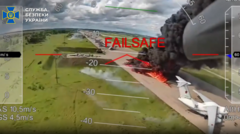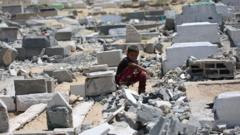A new study highlights the staggering toll of nearly 1.4 million military casualties over three years of conflict in Ukraine, involving both Russian and Ukrainian forces amid stagnant territorial gains.
Staggering Casualty Figures in Ukraine Conflict: A Comprehensive Analysis

Staggering Casualty Figures in Ukraine Conflict: A Comprehensive Analysis
Recent estimates reveal immense human costs in the Ukraine war, drawing urgent attention to the ongoing crisis.
In a sweeping analysis of military loss in Ukraine, a report released by the Center for Strategic and International Studies calculated that approximately 1 million Russian soldiers have either been killed or wounded since the war began, with an additional 400,000 Ukrainian troops also suffering similar fates. The total combined military casualties stand at an alarming 1.4 million. This data underscores the grueling and prolonged nature of the conflict, which has continued for over three years without a decisive resolution.
While the figures reflect a heavy human toll, the think tank emphasized that estimating casualties accurately is quite challenging, raising questions about the reliability of such numbers. Nevertheless, the report paints a troubling picture of the conflict's grinding reality, particularly as it noted that Russia's territorial acquisitions have been frustratingly slow, mirroring the laborious advances of British and French troops during World War I's Somme campaign. Since January 2024, Russia has managed to capture less than one percent of Ukrainian territory.
On the ground, Ukraine has sought to assert control and resist further incursions. Recently, Ukrainian forces reported successfully striking the strategically significant Crimean bridge for the third time, a testament to their ongoing efforts to disrupt Russian supply lines. Additionally, the emergence of remotely-operated Ukrainian drones inside Russia has marked a new tactic in the conflict, with video evidence emerging of these UAVs targeting Russian airfields.
In a related diplomatic development, tensions surrounding Iran's nuclear program have surfaced, as the U.S. proposed updated terms in ongoing discussions with Tehran. Following a recent diplomatic initiative crafted by President Trump’s Middle East envoy, the U.S. presented a new arrangement that allows Iran to maintain low-level uranium enrichment, which is suitable for peaceful energy purposes but not weapons. This development could potentially lead to more comprehensive negotiations aimed at curbing Iran's nuclear ambitions.
Such complex developments both on the battlefield in Ukraine and in diplomacy with Iran illustrate the multifaceted nature of geopolitical strife today, with human costs often overshadowed by shifting political landscapes and strategic interests.
While the figures reflect a heavy human toll, the think tank emphasized that estimating casualties accurately is quite challenging, raising questions about the reliability of such numbers. Nevertheless, the report paints a troubling picture of the conflict's grinding reality, particularly as it noted that Russia's territorial acquisitions have been frustratingly slow, mirroring the laborious advances of British and French troops during World War I's Somme campaign. Since January 2024, Russia has managed to capture less than one percent of Ukrainian territory.
On the ground, Ukraine has sought to assert control and resist further incursions. Recently, Ukrainian forces reported successfully striking the strategically significant Crimean bridge for the third time, a testament to their ongoing efforts to disrupt Russian supply lines. Additionally, the emergence of remotely-operated Ukrainian drones inside Russia has marked a new tactic in the conflict, with video evidence emerging of these UAVs targeting Russian airfields.
In a related diplomatic development, tensions surrounding Iran's nuclear program have surfaced, as the U.S. proposed updated terms in ongoing discussions with Tehran. Following a recent diplomatic initiative crafted by President Trump’s Middle East envoy, the U.S. presented a new arrangement that allows Iran to maintain low-level uranium enrichment, which is suitable for peaceful energy purposes but not weapons. This development could potentially lead to more comprehensive negotiations aimed at curbing Iran's nuclear ambitions.
Such complex developments both on the battlefield in Ukraine and in diplomacy with Iran illustrate the multifaceted nature of geopolitical strife today, with human costs often overshadowed by shifting political landscapes and strategic interests.






















